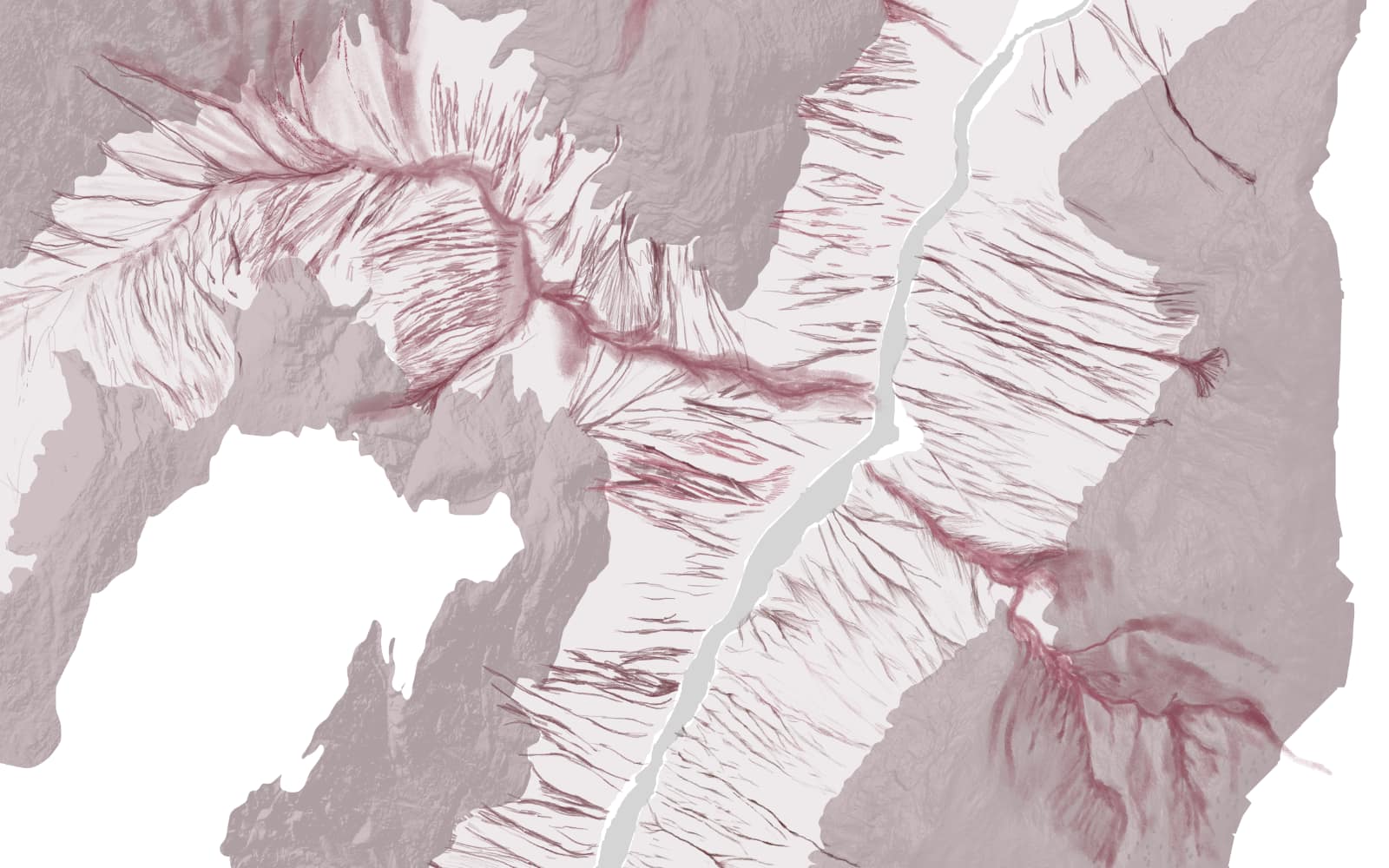Drawing Cartography into Movements and Flows
Downloads
DOI:
https://doi.org/10.47982/spool.2025.2.05Keywords:
Landscape architecture, cartography, LiDAR, interpretation, large-scale landscapes, more-than-human, natural hazards, rock, waterAbstract
In the urgent context of climate adaptation, enhancing representational and design tools within the landscape discipline is crucial for building a comprehensive understanding of the natural processes driving phenomena in hazardous landscapes. Moreover, the context of the more-than-human paradigm poses new challenges. If we view water, soil, and rocks as lively processes and nonhuman actants—agents with their own agencies and rights—how can mapping practices help us better understand, interpret, and recognize their processes, movements, and behaviors?
Based on an interpretative cartographic technique using LiDAR imagery, this paper introduces a series of cartographic experiments that depict water and rock as dynamic, lively processes. The resulting maps aim to enrich our representations of the forces driving natural hazards and provide a new “language” that enhances our understanding of their multiple agencies.
How to Cite
Published
Issue
Section
Categories
References
Aït-Touati, F., Arènes, A., & Grégoire, A. (2022). Terra Forma, A Book of Speculative Maps. The MIT Press.
Aït-Touati, F. A. A., Alexandra; Grégoire, Axelle. (2021). Terra Forma, Mapping Ruined Soils. Feral Atlas. Retrieved 21. May 2024, from https://feralatlas.supdigital.org/
Arènes, A. (2017). Tracer les vivants. BILLEBAUDE, 10.
Bennett, J. (2010). Vibrant Matter, A Political Ecology of Things. Duke University Press. https://doi.org/10.2307/j.ctv111jh6w
Bjørnerud, M. (2018). Timefulness: How Thinking Like a Geologist Can Help Save the World. Princeton University Press.
Bracke, B., Bonin, S., Notteboom, B., & Leinfelder, H. (2022). A multispecies design approach in the Eure valley. Three lessons from a design studio in landscape architecture. Les Cahiers de la Recherche Architecturale, Urbaine et Paysagere, 2022(14). https://doi.org/10.4000/craup.9824
Clément, G. (2014). L’alternative ambiante. Sens et Tonka.
Corner, J. (2011). The Agency of Mapping: Speculation, Critique, and Invention. In R. K. Martin Dodge, Chris Perkins (Ed.), The Map Reader: Theories of Mapping Practice and Cartographic Representation (First edition ed.). John Wiley & Sons. (1999: Chapter 10 in Mappings (ed. Denis Cosgrove), Reaktion, London, pp. 213–252.
de Toledo, C. (2021). Le fleuve qui voulait écrire: Les auditions du parlement de Loire. Les Liens qui Libèrent.
Descola, P. (2019). Une écologie des relations. CNRS Editions.
Elkin, R. S. (2017). Live Matter: Towards a theory of plant life. Journal of Landscape Architecture, 12(2), 60–73. https://doi.org/10.1080/18626033.2017.1361087
Ezban, M. (2023). Attune and Entangle: Designing Multispecies Relations for the Sixth Extinction. In B. K. Rosalea Monacella (Ed.), Designing Landscape Architectural Education: Studio Ecologies for Unpredictable Futures (pp. 358–371). Routledge. https://doi.org/10.4324/9781003145905
Herrington, S. (2010). The Nature of Ian McHarg’s Science. Landscape Journal, pp. 29, 1–20. https://doi.org/10.3368/lj.29.1.1
Latour, B. (2017). Inside - A Performance Lecture, Youtube. http://www.bruno-latour.fr/node/755.html
Mattern, S. (2017). Mapping’s Intelligent Agents. Places Journal. https://doi.org/https://doi.org/10.22269/170926
Morizot, B. (2020). Manières d’être vivant [Ways of being alive]. Actes Sud.
November, V., Camacho-Hübner, E., & Latour, B. (2010). Entering a Risky Territory: Space in the Age of Digital Navigation. Environment and Planning D: Society and Space, 28(4), 581-599. https://doi.org/10.1068/d10409
Palmboom, F., Notteboom, B., Dimitrova, K., & Decroos, B. (2020). The Drawing in Landscape Design and Urbanism. OASE, 107 (The Drawing in Landscape Design and Urbanism), 1–10.
Prominski, M. (2014). Landscapes: Concepts of nature and culture for landscape architecture in the ‘Anthropocene’. Journal of Landscape Architecture, 9(1), 6–19. https://doi.org/10.1080/18626033.2014.898819
Rønningsbakk, I. (2018). Klimaendringer vil føre til våtere vær på Vestlandet. CICERO, Senter for Klimaforsking. https://cicero.oslo.no/no/artikler/klimaendringer-vil-fore-til-vatere-vaer-pa-vestlandet
Sijmons, D. (2020). In the Anthropocene, Site Matters in Four Ways. In A. Kahn & C. J. Burns (Ed.), Site Matters, Strategies for Uncertainty Through Panning and Design (2nd edition ed., pp. 308). Routledge.
Tsing, A., Deger, J., & Keleman Saxena, A. (2021). Feral Atlas: The More-than-Human Anthropocene. Stanford University Press. https://feralatlas.org/
Tsing, A. L. (2015). The Mushroom at the End of the World: On the Possibility of Life in Capitalist Ruins (1st ed.). Princeton University Press.
van Dooren, N., & Nielsen, A. B. (2019). The representation of time: addressing a theoretical flaw in landscape architecture. Landscape Research, 44(8), 997-1013. https://doi.org/10.1080/01426397.2018.1549655
Wolff, J. (2017). Lexicon as Theory: Some Definitions at the Edge of San Francisco Bay. In E. Zûrich (Ed.), gta Verlag (Girot, Christophe, Ahn, Susann, Fehlmann, Isabelle; Mehling, Lara ed., Vol. 20, pp. p 15). Zürich, Switzerland: Christophe Girot.





